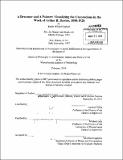A dreamer and a painter : visualizing the unconscious in the work of Arthur B. Davies, 1890-1920
Author(s)
Gephart, Emily Willard
DownloadFull printable version (43.62Mb)
Alternative title
Visualizing the unconscious in the work of Arthur B. Davies, 1890-1920
Other Contributors
Massachusetts Institute of Technology. Department of Architecture.
Advisor
Caroline Jones and Michael Leja.
Terms of use
Metadata
Show full item recordAbstract
The paintings of U. S. artist Arthur B. Davies (1863-1928) spoke to his viewers in terms of the emergent discipline of psychology, creating visualizations of dreaming. This dissertation examines his work and its reception between 1890 and 1920, exploring the diversity characterizing American beliefs about dreams and their function in the unconscious. Painted during a period in which shifting, coalescing disciplines contested the understanding of the inner world of the modern psyche, Davies's art uneasily blended figuration and looser forms of representation, calling up the ambivalence with which his contemporaries greeted profound socio-cultural changes in the Gilded Age and Progressive Era. As I show in five chapters that parallel the trajectory of the artist's career, the discourses of Symbolism, science, spiritualism, psychoanalysis, and various forms of modernism all laid claim to the value of dreams and to Davies's art in wide-ranging, even contradictory ways. Reading Davies's paintings in light of critical responses and popular sources, I examine his varied reception across the art world. First, Sadakichi Hartmann's arguments for Davies's ability to capture suggestive, visionary meaning of Symbolist dreams in the 1890s asserted his paintings' significance as transcendent forms of creative imagination. Then, as psychology emerged as a discipline, Davies's paintings were reinterpreted in light of newly scientific approaches to the unconscious. These claims were paralleled by the competing and overlapping tenets of Spiritualism, the pursuit of psychic research, and the foundation of new religions and forms of popular psychotherapy. After 1909, views of the subconscious began to coalesce under the psychoanalytic approaches offered by Sigmund Freud and Carl Jung, which nonetheless blended with the philosophies of Henri Bergson, to extend and also challenge prior interpretations of dreams. In the teens when Davies explored Cubist form after his involvement with the Armory Show, Havelock Ellis's ideas about the synaesthetic operation of dreams provided yet another framework by which critics interpreted the artist's hybrid interests. Despite his popularity in his own time, Davies's is largely absent from art historical narratives today. I argue that epistemic changes shaped his art's perceived quality, relevance, and even its visibility.
Description
Thesis: Ph. D. in Architecture, History and Theory of Art, Massachusetts Institute of Technology, Department of Architecture, 2014. Cataloged from PDF version of thesis. Includes bibliographical references (pages 495-524).
Date issued
2014Department
Massachusetts Institute of Technology. Department of ArchitecturePublisher
Massachusetts Institute of Technology
Keywords
Architecture.